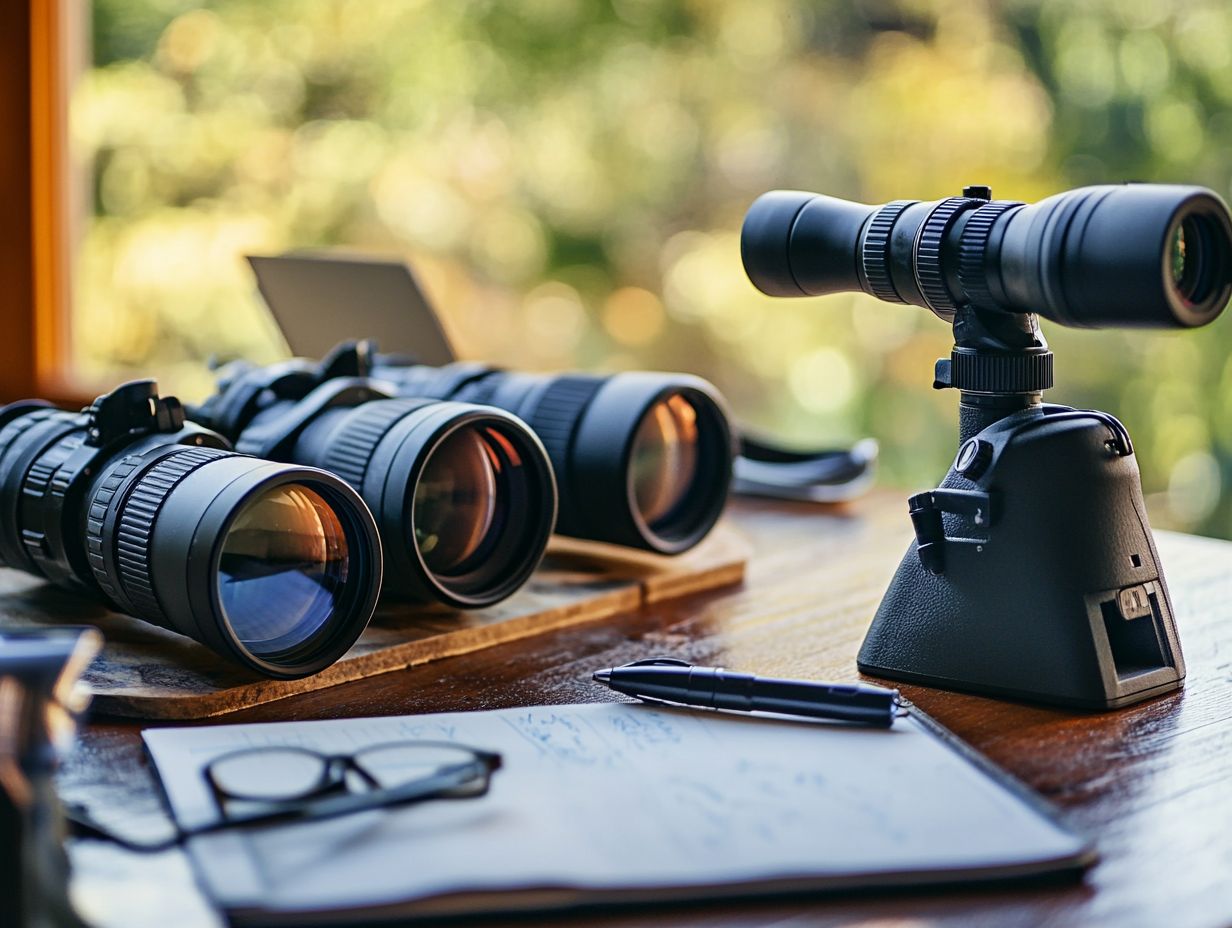Comparing Spotting Scopes: Angled vs. Straight
Spotting scopes are indispensable tools for birdwatchers, hunters, and nature enthusiasts, offering a closer look at distant subjects.
With two primary styles angled and straight selecting the right one for your specific needs can be a bit daunting. This article delves into the unique advantages of each design, highlights key features to consider, and provides practical tips for using and maintaining your scope.
Whether you re in search of comfort, stability, or simply the best view, understanding these choices will truly transform your outdoor adventures!
Contents
- Key Takeaways:
- Understanding Spotting Scopes
- Benefits of Angled Spotting Scopes
- Benefits of Straight Spotting Scopes
- Factors to Consider When Choosing Between Angled and Straight
- Features to Look for in Both Types
- Tips for Using and Maintaining Your Spotting Scope
- Frequently Asked Questions
- What is the difference between an angled and straight spotting scope?
- Which is better for bird watching, an angled or straight spotting scope?
- Does the angle of the spotting scope affect the image quality?
- Which type of spotting scope is easier to use for long periods?
- Do angled and straight spotting scopes have different price points?
- Is one type of spotting scope better for hunting?
Key Takeaways:

- Angled spotting scopes offer improved comfort and versatility, making them ideal for longer periods of use and varying terrain.
- Straight spotting scopes provide increased stability and ease of use, making them a better choice for beginners and those needing precise movement.
- When choosing between angled and straight spotting scopes, consider your intended use and personal preference, as well as important features for quality and performance.
Understanding Spotting Scopes
Spotting scopes are remarkable optical instruments crafted for long-distance viewing. They are critical for activities like hunting, birdwatching, and wildlife observation.
You ll encounter two main types: angled spotting scopes and straight spotting scopes. Each brings its own set of advantages tailored for specific situations.
Thanks to advancements in technology and design, today s spotting scopes elevate your target acquisition and offer an outstanding field of view. This makes them a must-have for any outdoor enthusiast.
Whether you re on the hunt for an antelope perched on a distant hillside or simply savoring hours of comfortable scanning for wildlife, understanding the nuances of these devices will undoubtedly enrich your experience.
What is a Spotting Scope?
A spotting scope is your go-to high-powered optical tool, designed to deliver exceptional magnification and clarity for observing distant objects. This makes it a favorite among hunters and wildlife enthusiasts alike.
These sophisticated instruments use advanced lens technology to boost image brightness and resolution. This allows you to identify targets with remarkable precision, even in low light conditions.
Typically, they feature a durable, waterproof construction, ensuring reliable performance even when the weather takes a turn for the worse. With various magnification levels at your disposal, spotting scopes offer the flexibility you need to observe different terrains and animals from impressive distances.
Their adjustable eyepieces and sturdy tripod mounts further enhance stability and comfort, making it easy to acquire your target whether you’re in open fields or navigating dense forests.
For anyone passionate about outdoor adventures, investing in a high-quality spotting scope can significantly elevate the overall experience.
Benefits of Angled Spotting Scopes
Angled spotting scopes present a range of advantages that enhance your experience during prolonged viewing sessions, especially when paired with a tripod that accommodates different heights. Their design facilitates more natural viewing angles, making it easier to observe steep terrain or share views with others.
This versatility is crucial for pursuits such as birdwatching, hunting, or using digital cameras, where comfort and effortless adjustment are of utmost importance.
Improved Comfort and Versatility
One of the standout benefits of angled spotting scopes is how they enhance your comfort during glassing sessions. With this design, you can maintain a relaxed posture while taking in distant objects no more awkward contortions.
This ergonomic approach is especially beneficial for long observation periods, as it significantly reduces strain on your neck and back. Many models come with specialized neck relief features, allowing you to easily adjust your position and share views with friends or family without any discomfort.
The angled eyepiece provides a more natural line of sight, making it simpler for you to spot wildlife or stunning landscapes without the need to bend or twist awkwardly.
These thoughtful design elements truly elevate your viewing experience, making it not just enjoyable but genuinely engaging.
Discover which spotting scope is perfect for you and elevate your outdoor explorations today!
Benefits of Straight Spotting Scopes

Experience crystal-clear views and steady observations with straight spotting scopes! They offer remarkable stability and user-friendly operation, making them an outstanding choice for those who demand precision and clarity when observing distant targets.
Their thoughtful design facilitates quick target acquisition and provides a direct line of sight. This proves especially advantageous in diverse hunting conditions.
Whether you re tracking a Whitetail Buck or scanning the horizon for game, the benefits of straight spotting scopes can elevate your outdoor experience.
Increased Stability and Ease of Use
The increased stability provided by straight spotting scopes is a significant advantage if you prioritize a steady view during your observations.
This stability is valuable during long periods of observation, as it minimizes tired eyes and enhances your overall comfort. The user-friendly design allows both beginners and seasoned enthusiasts to adjust your positioning effortlessly.
Features like wide viewing angles and smooth focusing mechanisms ensure you enjoy clear, sharp images. Maneuverability becomes a breeze, allowing you to spend extended sessions in the field.
Whether you re birdwatching, hunting, or soaking in the beauty of nature, these practical attributes elevate your experience.
Factors to Consider When Choosing Between Angled and Straight
When choosing between angled and straight spotting scopes, several factors come into play, especially your intended use and personal preference.
Each type offers unique advantages; for instance, angled scopes provide comfortable viewing angles, while straight models deliver a direct line of sight.
Understanding your specific needs whether for hunting or observation can help you make an informed choice that enhances your target acquisition experience.
Intended Use and Personal Preference
The intended use of your spotting scope is crucial in deciding between angled and straight models.
If you re engaged in hunting, you might favor straight spotting scopes. They provide a streamlined view for quicker target acquisition, allowing you to efficiently observe your surroundings.
If birdwatching is your passion, angled scopes can be your best friend. They offer a more comfortable viewing experience, helping you maintain a relaxed position while aiming at high-flying birds or distant treetops.
Grasping these nuances is essential for anyone eager to enhance their outdoor experiences and ensure their equipment seamlessly aligns with their pursuits.
Features to Look for in Both Types
When choosing a spotting scope, whether you prefer an angled design or a straight one, consider several key features to guarantee optimal performance and usability.
Pay attention to adjustable mounting collars and ensure you select a model that offers a suitable field of view, which means how much you can see through the scope, tailored to your needs.
Important Factors for Quality and Performance

Quality and performance in spotting scopes depend on several key factors, including the type of optical tools you choose and the specified field of view.
The coatings on the lenses, whether multi-coated or fully multi-coated, enhance light transmission and reduce glare, allowing you to enjoy clearer images even in low-light conditions.
The size of the objective lens is equally important; larger lenses gather more light, delivering brighter and sharper images.
Understanding magnification levels is essential. While higher magnification reveals finer details, it often requires a steadier hand to maintain clarity. All these elements, along with the construction materials used, determine how durable and versatile your spotting scope will be in various environments.
Explore our range of spotting scopes today and elevate your outdoor adventures!
Tips for Using and Maintaining Your Spotting Scope
Using and maintaining your spotting scope correctly is essential for its longevity and optimal performance. This ensures easy viewing for years to come.
Familiarize yourself with proper techniques, like adjusting the tripod height and cleaning the optics. These actions will greatly enhance your viewing experience and improve how you find your target.
Proper Technique and Care
Proper technique and care are vital for maintaining your spotting scope’s functionality. These practices enhance your overall observation experience.
Pay attention to handling, cleaning, and storage. Avoid touching the lens with your fingers, as oils and dirt can compromise clarity.
When it’s time to clean, use a soft brush or a lens cloth designed for optics. This will help prevent scratches and remove dust.
After use, always store the scope in a protective case or its original packaging. This prevents damage from environmental factors and keeps your observations crystal clear.
Frequently Asked Questions
What is the difference between an angled and straight spotting scope?
An angled spotting scope is set at a 45-degree angle, while a straight spotting scope is inline with the eyepiece. For those considering which type to choose, spotting scope comparisons: high-end vs. budget can help inform your decision, as this affects your viewing angle and comfort.
Which is better for bird watching, an angled or straight spotting scope?

Many bird watchers prefer an angled scope for easier viewing of birds in trees. A straight scope may be more comfortable for observing ground-level birds.
Does the angle of the spotting scope affect the image quality?
No, the angle does not affect image quality. Both types can produce high-quality images.
Which type of spotting scope is easier to use for long periods?
An angled scope is generally more comfortable for extended use. It allows a more natural posture, reducing neck strain.
Do angled and straight spotting scopes have different price points?
Not necessarily. Price varies based on brand, magnification, and lens quality, not the angle of the scope.
Is one type of spotting scope better for hunting?
It depends on personal preference. Some hunters prefer angled scopes for their versatility in observing animals at various heights.






